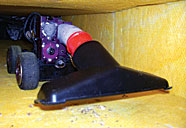
As time progressed, however, so did duct-cleaning methods. Encapsulation became the new trend. This method required duct cleaners to spray a sticky substance into the ductwork, effectively gluing contaminants in place. The theory held that once a particulate or object was glued in place, it could no longer travel through the ductwork and contaminate the system.
Consumers didn't appreciate this idea, though, and it was abandoned as the National Air Duct Cleaners Association (NADCA) began requiring source removal from duct cleaners, mandating a clean and contaminant-free system.
Enter the robots. Among other entries into this market, Loran Hubbard and his team from Lindhardt Technical Services, Salt Lake City, developed Versa-Bot, a product that combines video games and duct cleaning.
VERSA-WHAT?
Versa-Bot is a duct-cleaning robot with multiple functions and applications. Weighing in at 4.5 pounds, this robot is made of hard, anodized aluminum and sports four motors, according to the company.It is a lightweight compared to other robotic duct cleaners that can weigh more than 20, 30, and 50 pounds. Versa-Bot also is adjustable in height. It is one of the only robotic duct cleaners able to clean ductwork as small as six inches and as large as 30 inches.
A high-output LED modular light and a 570-line, low-LUX video camera are mounted on Versa-Bot's main drive platform. With a reach of 150 feet, the robot is able to enter ductwork on tracks or wheels, allowing it footing on almost any terrain.
The feed is sent to a 10.4-inch high-resolution color monitor that is included with the system. The robot is controlled by a single stick control.
The company claims this tool makes duct cleaning easier by allowing "unprecedented" access to ductwork that was formerly unreachable. "Two key things are its size and power," said Hubbard. "By the time you get some robots in the ductwork, you may as well have sent a person in."
WELL-VERSED
Hubbard originally came up with the idea for this robot series in 2001. While working at a school system with a large inspector robot, he found it was easy to see the contaminants, dirt, and objects in the system, but the robot wasn't able to do anything about it and a technician couldn't reach it.After further examination of the different robots available, Hubbard decided that they wouldn't work for the company's purpose. He began designing one from the ground up. By the spring of 2002, machinist Shirl Rawson, electrical engineer Harold Bird, field supervisor Ted Brown, and equipment assembly and maintenance technician Martin Smith, were officially new parents.
The nascent Versa-Bot grew in 2002, when painting and brush modules were completed. The patent-pending device received a vacuum/blower attachment in 2003, and a newly developed dry ice module in 2005.
VERSA-TILE
Versa-Bot allows for multiple applications. Its cameras, monitor, and controls are contained in a Pelicanâ„¢ case, a hard-bodied, well-protected container. The modules are contained separately in their own Pelican cases.The unit requires 110 or 220 V single-phase ac. The vacuum/blower and brush modules require an air compressor capable of 30 cubic feet per minute (cfm) at 90-120 psi. The coating module requires an airless paint pump capable of at least 1 gallon per minute (gpm) at 3,300 psi, according to Hubbard.
"Setup on the robot is quick," he said. "Running air hoses from the compressor probably takes the most time. However, once the robot is in place, it can clean and coat all sides of the vent up to 150 feet from a single access point, thus reducing the time involved in multiple setups."
In the duct-cleaning business, size and power matter. Versa-Bot can carry a 1/2-hp brush motor and a vacuum equal to a powerful Shop-Vac®. It can remotely apply "fosters-type" coatings to the entire duct simultaneously, said the company.
It also allows access above hard deck ceilings, under slab floors, into adjacent rooms, and around multiple corners with complete vision and control, the company said. Skilled operation of the robot takes a little time and practice, but it has been Hubbard's experience that most technicians are able to operate it in less than a minute.
Versa-Bot has been used to clean the piping inlets to three one-of-a-kind compressors valued at $3 million each, and to clean the ductwork above a high-security software development company while the company remained in operation, with little intrusion into the office environment, Hubbard said.
"We once found during cleaning, a 20-inch-diameter sheet metal elbow inadvertently left during construction in a main supply," said Hubbard.
"We also used our equipment to clean the air ducts in a large cash vault containing tens of millions of dollars. While doing so, our robot revealed that part of their security system in the ductwork had been improperly installed."
Currently the team is working on a few new modules, such as a focusing micro camera that can give the operator the ability to zoom in on an area.
"We wanted tools that would work for us," said Hubbard. "We figured the machines were doing so well for us that maybe others would want to use them too."
For more information, contact Loran Hubbard at loran@lindhardt-techserv.com.
Publication date: 07/17/2006


Report Abusive Comment